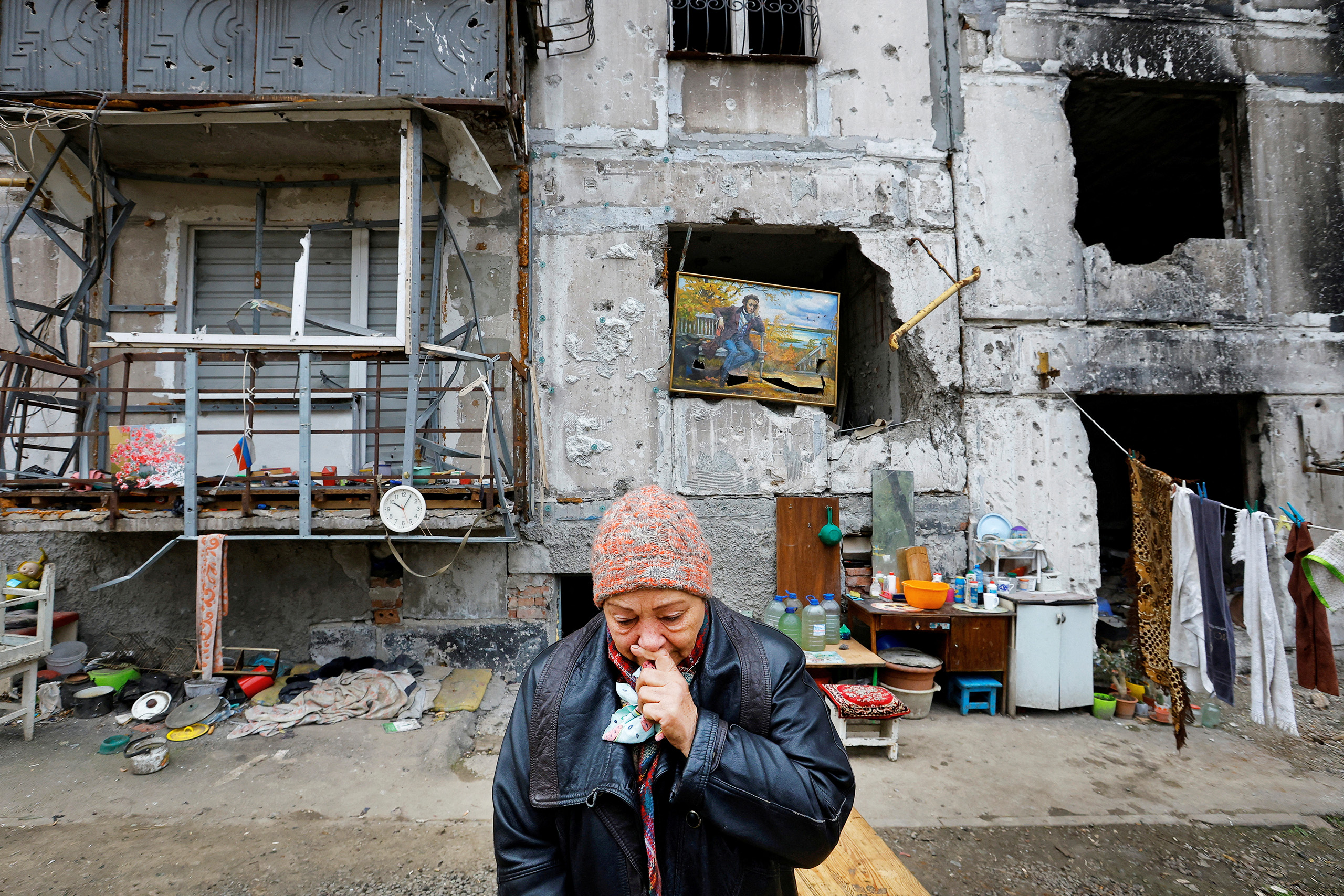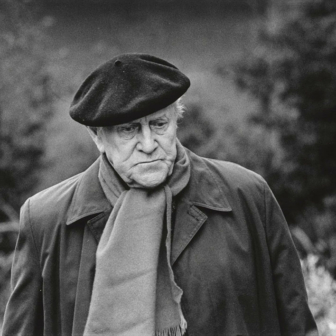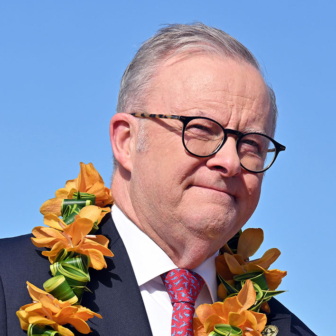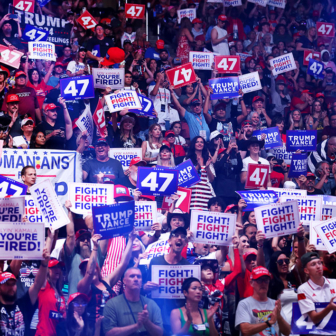Since Russia launched its full-scale invasion of Ukraine three years ago, the world’s attention has focused on what quickly became a grinding war of attrition, with its endless drone and missile attacks on Ukrainian cities. In Russian-occupied territories, though, an equally insidious dimension of the conflict has unfolded in relative silence.
Covering an area the size of South Korea, these five annexed Ukrainian provinces — victims of the world’s biggest land grab since the Second World War — have been subjected to a brutal occupation. Rather than maintaining a temporary wartime occupation, Russia is attempting to absorb them in perpetuity and wipe out any evidence of Ukrainian identity.
While perhaps a dozen books have been published on the invasion, English political scientist David Lewis’s Occupation: Russian Rule in South-Eastern Ukraine is the first to focus solely on the takeover. He does so with great thoroughness and in chilling detail, explaining the systematic yet chaotic, thuggish and corrupt nature of the occupation. The resulting picture mixes together Hitler’s Reichskommissariat Ukraine, Orwell’s 1984, Puzo’s The Godfather and Russian satirists like Gogol and Voinovich. Ukrainian activists have justly labelled the regime a “silent terror,” akin to living in an open-air gulag.
The occupied territories became the main target of the invasion after Ukrainian forces repelled the early assault on Kyiv. Donetsk, Luhansk, Zaporizhzhia and Kherson form a crucial land bridge between Russia and Vladimir Putin’s prized possession, Crimea, captured and annexed in 2014. Given its solid minority of ethnic Russians — perhaps one in four residents — this region was more vulnerable to Russian occupation than other parts of Ukraine, although Lewis underlines the extent to which the population had hybrid identities: by 2017, polls showed that only one in twenty residents considered themselves “only Russian” as opposed to both Russian and Ukrainian.
The nature and scale of the Russian occupation has barely been covered by mainstream media. No respectable international news organisations have been allowed to work there, and nor have UN or other international agencies and NGOs. The number of Ukrainian civilian dead, mostly in the early months of the war, could be twice as high as in Gaza, but is impossible to verify. In a world of “if it bleeds, it leads,” footage of intrepid journalists in frontline trenches or the wreckage of bombed buildings is much more likely to be screened than interviews with people who have been tortured or had their businesses expropriated.
Analyses of the Russian-occupied territories often rely on surreptitious phone interviews, messages from residents remaining in these heavily censored zones or testimony from Ukrainians who have fled the area. By necessity, they also draw on Kremlin-friendly Russian news and social media sites and Russian government agencies, as well as outstanding work by independent Ukrainian and Russian journalists and investigators. The UN has issued major reports through the Office of the High Commissioner for Human Rights and its rapporteur on torture (Australian Alice Edwards), as have Amnesty International, Human Rights Watch and other non-government agencies.
Lewis himself has gathered a mountain of meticulously documented evidence from Russian and Ukrainian sources, including interviews with Ukrainians, that reinforces the broader conclusions of such reports. He focuses on four main tools the occupation regime uses to make Russian control permanent: the legal-administrative framework; violence; propaganda and indoctrination; and economic levers, expropriation and theft.
Despite the meticulous crafting, the carapace of legality the Kremlin created around the annexations and occupation was patently thin. Although it occupies none of them entirely, Russia formally incorporated the four provinces of Zaporizhzhia, Kherson, Donetsk and Luhansk in September 2022 (much of the latter two had been under de facto Russian control since 2014). This was no simple declaration of annexation but an elaborately concocted process of sham referendums in each region, followed by requests from these newly “independent” entities to join the Russian Federation. The Russian parliament then graciously considered and approved their accession.
All this was executed over a matter of days, with “yes” votes as high as the Donetsk region’s 99.9 per cent (on a 97.5 per cent turnout), surpassing even Soviet election figures at their most implausible. Despite the rigging, the authorities felt obliged to send polling officials, accompanied by soldiers, to people’s homes to encourage the appearance of a solid turnout. Ignored was the fact that up to half the prewar population — up to four million people — had fled in the wake of the invasion and couldn’t or wouldn’t return to vote. Surveys prior to 2022 had shown an overwhelming majority of people in southeastern Ukraine — around 70 per cent — rejected any unification with Russia.
After the “accession” of the annexed territories, Russia introduced the full gamut of legislative and administrative machinery: laws, ministries, agencies, local government, currency, banking, police, social services and passports. Ukrainians in the occupied zones can’t access healthcare, pensions or other benefits and services without accepting Russian passports and citizenship, which entails an oath of loyalty. Access to government services more broadly is weaponised to ensure political and social control.
All these measures, it should be stressed, are a grotesque violation of international law on belligerent occupation. The Fourth Geneva Convention and customary international law oblige an occupying power not to interfere in local laws, customs and governance unless there is a pressing security need. Russia hasn’t made the slightest pretence of compliance.
The whole occupation and assimilation enterprise was overseen by Russian security forces, notably the FSB internal security police, and ultimately supervised by Putin’s all-powerful presidential administration. The new regional and local administrations drafted in or recruited many officials from Russia proper, though the regime also relies on locals to staff many positions.
Some of those locals took roles in the new bureaucracy because they were ethnically Russian or pro-Russian, but the main drivers of collaboration were new career prospects, ambition, higher salaries and resentment at the Ukrainian political class that had ousted or thwarted them. Others took jobs because they had few alternatives, saw them as politically neutral, or were coerced.
The occupation unfolded somewhat chaotically because parts of the Russian system knew nothing of the tightly held plans for invasion. Its overall effectiveness drew on experience and methods developed in other occupations: the Soviet takeover of Eastern Europe after the Second World War and, more recently, the occupations of Afghanistan, Chechnya, Crimea and parts of Syria. Those conflicts, as well as the Stalinist system, were also laboratories for developing a military-security culture that emphasises extreme violence and a disregard for legal rules.
More publicised than most aspects of occupation has been Russia’s use of violence to enforce control. But its extent is still widely unappreciated. Investigators identified well over one hundred centres where Russian security forces have tortured Ukrainians who might oppose the new regime, including politicians, officials, civic activists, journalists, police, military veterans, and priests or members of churches not aligned with Moscow (notably the Orthodox Church of Ukraine and various Protestant groups). One investigation found that more than eight in every ten survivors of Russian captivity reported having been subjected to severe torture.
Common among the various techniques used were electric shocks (reported by nearly two-thirds of survivors), often using old field telephones with a manual crank to generate a shock. Victims relate the use of variants nicknamed “the phone call to Zelensky” (applied to the genitalia) and “the call to Biden” (attached to the anus).
Beatings and mock executions, rape and other sexual violence, extra-judicial killings, abductions and disappearances have all been widespread, along with forced migration and the deportation of children taken from orphanages and state boarding schools or because they had simply become separated from parents. Ukraine has listed more than 61,000 people as missing from the region since 2022, many suspected to have been imprisoned in Russia or murdered.
Precise numbers are still unclear in most categories. Ukrainian investigators recorded more than 108,000 war crimes by Russian forces by September 2023 alone. The International Criminal Court indicted Putin for war crimes over the deportations of children. The ICC or a Nuremberg-like tribunal would be kept busy for decades if every credible allegation was prosecuted and evidence was available.
Russia also embarked on what Lewis calls a “cognitive occupation” aimed at transforming the consciousness of people living under Russian rule and obliterating the Ukrainian past. Media, internet and phone communications are tightly managed, and access to anything but Russian networks and channels is blocked as far as possible.
Russification of the education system includes abolishing tuition in Ukrainian language (which had been standard) and using history lessons as a form of indoctrination. The latter extol Russian greatness while eschewing any delving into darker aspects of the Soviet and Tsarist past, and inculcate the Kremlin’s line that Ukraine isn’t a real country. Teachers have been sent on retraining courses where are told the main global enemies are the “Anglo-Saxons.” Lists of books banned from libraries include any literature “propagandising European gender values,” an ironic echo of contentious decisions being made in some American towns and states.
Aside from new history textbooks, new courses, and campaigns using film, television and theatre, Russia deployed multimedia exhibitions in museums and “history parks.” Opening one exhibition, the head of the history parks organisation declared: “We are defending historical truth and returning the good name to Peter’s, Catherine’s, Alexander’s, and Nicholas’s victories on this primordially Russian land.”
Russian nationalists do indeed reimagine southeastern Ukraine as the province of Novorossiya (New Russia) forged by Catherine the Great and her successors. But while much of the region was newly settled and developed agriculturally and industrially by the Russians, and while it had a very mixed population, Novorossiya was nonetheless largely Ukrainian in ethnic composition.
Wiping out traces of Ukrainian identity includes destroying monuments, erasing symbols and restoring former Soviet names to places and streets that had been renamed for Ukrainians in the 1990s post-Soviet “decommunisation” campaign. A plethora of Karl Marx Squares and Lenin Streets has reappeared, despite the fact that Marx would turn in his grave at being linked to Putin’s crony capitalist regime. The renaming is made even more absurd by the fact that Putin himself has blamed Lenin and the Bolsheviks for creating an artificial Ukrainian republic in the USSR. But why worry about details when the aim is simply to wipe out traces of Ukraine?
Ukrainian artworks and cultural items are being removed wholesale from museums and galleries (10,000 from Kherson alone). And Moscow has also set about “recoding” Ukrainian youth to be loyal young Russians. The insidiousness ideological control is exemplified by the sophisticated surveillance of teenagers’ mobile phones and use of the internet by organisations with catchy Orwellian titles like the Centre for the Study and Network Monitoring of the Youth Environment, or TsISM.
Lewis elucidates the extraordinary extent to which occupation authorities, security agencies and their cronies have deployed expropriation, dubious legal mechanisms and straight coercion to steal a vast number of Ukrainian businesses, properties and dwelling. Economic levers — pensions, bank accounts, salaries, contracts — are also being used to reward loyalty and punish rebellion.
A favourite trick has been to give a short deadline, a matter of days, for owners who have fled the fighting to claim a business or an apartment announced as “abandoned.” If they can’t meet that absurd deadline their property is expropriated. Owners rarely comply in time, or are even aware of the need to comply. The spoils are often given to cronies of local politicians or officials, no doubt accompanied by kickbacks. By the end of 2022 alone, some 30,000 Ukrainian legal entities had been re-registered in the Russian corporate register. Nearly all these forms of expropriation are, again, clear violations of the Geneva Conventions.
In the early stages of the occupation, large amounts of property were plundered by Russian soldiers with virtual impunity. Other looting was clearly organised by the military and security agencies: Ukrainian company Metinvest, for instance, claims that Russian groups stole as much as US$600 million worth of steel and other products from its metallurgical plants. At lower levels, traditional mafia tactics — kidnap for ransom, shakedowns and protection rackets — were rife, but in this case perpetrated by agents of the Russian state.
The disposal of stolen mines, metal plants, grain exporters and other big businesses came under Moscow’s purview. The hierarchy of entitlement flows from dons in the Kremlin to local lieutenants (or Gauleiters as Ukrainians have dubbed them) on to capos and enforcers in the FSB. Occupation teases out in detail the crony-capitalist networks prevalent in the newly captured territory.
Russia’s construction ministry oversees a large program of rebuilding and renewal works in cities like Mariupol, which was largely destroyed or damaged in the first months of the invasion. The rapid rebuilding has been very effective, if not efficient, in building new housing and infrastructure, notwithstanding all the skimming, milking and underhand dealing. But many residents who lost their apartments in the bombing and fighting are unable either to access or afford new ones, which are often creamed off by wheeler-dealers and sold to investors or to Russian buyers attracted by the idea of an apartment by the Azov Sea ($100,000 for a two-bedder, just fifteen minutes’ walk from the water, anyone?).
As well as exploring those dimensions of occupation, Lewis succinctly explains the background to the invasion and why, beyond geographic proximity and the land bridge to Crimea, southeastern Ukraine became the frontline. Its roots are a complex nexus of geopolitics, Russian imperialism, the Kremlin’s fear of democratic “colour revolutions” in neighbouring states, and legacies of Russian colonialisation and Soviet development.
A key geopolitical element was Russian leaders’ resentment at losing global status and empire, compounded by perceived slights over issues like Kosovo, Iraq and Libya. Less important was the oft-touted threat posed by NATO expansion (which Russia had already rendered moot by 2022 thanks to its occupation of Crimea and the Donbas). The imperialist and ethnocidal nature of the annexations and forced assimilation into Russia certainly makes a mockery of claims that Putin invaded primarily because of the NATO threat.
Ukraine seems to have little prospect of pushing back Russian lines significantly in the short term. Sabotage and assassinations have inflicted some damage on the occupation and its personnel: using social media postings, one scholar calculated that seventy-three Russian soldiers, police officers and officials were killed by partisan movements in just one two-month period. But resistance doesn’t appear to have caused insuperable problems for the Russians.
Lewis highlights the challenges of unscrambling the omelette the longer the occupation continues. In the unlikely event of reclaiming control over these territories, what would the future be for those who have collaborated with the occupying power? Many of the millions of potential returnees who fled war and Russian occupation would feel aggrieved by those who remained and how they behaved. If the land isn’t recaptured, will Ukrainians have a right of return? What kind of anger and violence will be stored up for the future towards Russia?
Recognising Russia’s annexations in any peace talks would sabotage the international consensus that territorial aggression and conquest is inadmissible, a view that has prevailed, almost uniformly, since the Second World War. But Donald Trump and his camp seem determined to pressure Ukraine into territorial concessions of some kind. They are less clear about whether this means ceding sovereignty over some or all captured land, or freezing the conflict without recognising Russian sovereignty and leaving their fate to be decided sometime in the future.
Parallels with Cold War Germany and Korea, sometimes mooted as models for postponing an ultimate resolution, are grievously misguided. Divided along ideological and military lines, these countries and nations nevertheless remained German or Korean on both sides. In Ukraine this would mean consolidating the absorption of one large part of Ukraine into Russia — not just its land, but its people and nationhood.
Some experts argue that the invasion and occupation meets the definition of genocide. It can certainly be described as an ethnocide. Are US or other leaders signing up to consecrate that? It is hard to see how even a freezing of the conflict, with a final resolution left in abeyance, could be credible unless (a) the annexations are legally revoked by Russia and (b) international organisations and observers are allowed in to encourage a modicum of compliance with international law.
Lewis deftly explores the nuances of identity, motivation and loyalty for people in the occupied zone and the challenges they face. Occupation’s themes are expounded not with a polemical sledgehammer but through meticulous attention to detail and analytical rigour. Nor does it play down the flaws in Ukraine’s policies and actions.
Occupation is a vital source document and framework for understanding what has occurred in Ukraine, although it may only represent the start of the process of unearthing the full story. As Lewis concludes, his and similar accounts may one day contribute to a process of rebuilding and reconciliation within Ukraine and between Ukraine and Russia. “But that will only happen,” he writes, “if the recording of historical facts, the painstaking work by war crimes investigators and the accounts by witnesses of these traumatic events eventually produce some form of justice and a reckoning.” •
Occupation: Russian Rule in South-Eastern Ukraine
By David Lewis | Hurst | £25 | 248 pages




